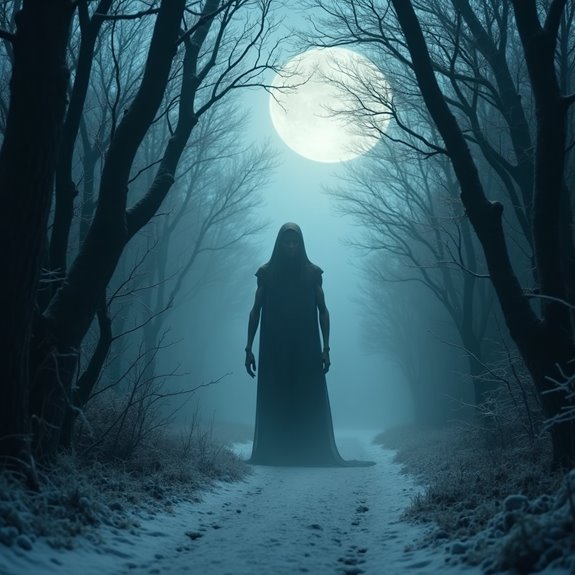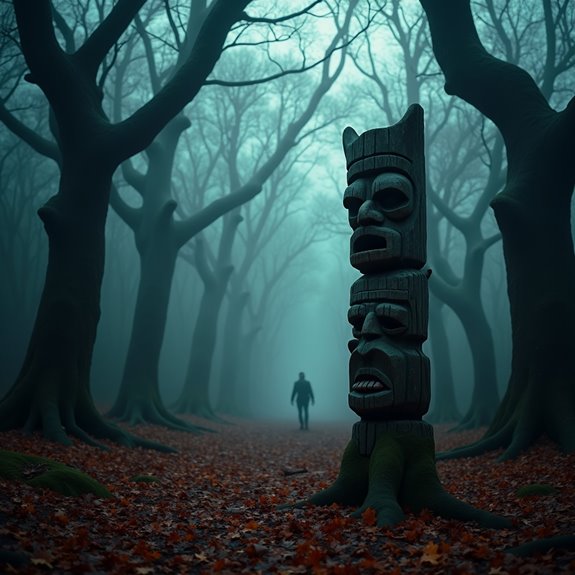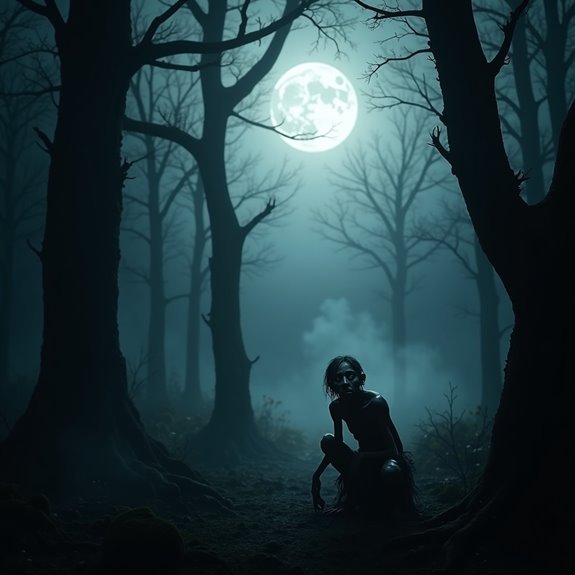The Wendigo Psychosis: Myth or Mental Illness?
The Wendigo psychosis presents a fascinating intersection of folklore and psychology. Emerging from Algonquian traditions, this condition embodies humanity’s darkest fears about cannibalism and survival. While some view it as a reflection of societal anxieties, others argue it’s a manifestation of mental illness mingled with cultural narratives. The complexities surrounding its legitimacy raise questions. Is it a genuine psychological disorder, or merely a cautionary tale? The answers might not be as clear-cut as one might think.
Introduction

Although many cultures have their own versions of mythical creatures, the Wendigo stands out due to its chilling association with cannibalism and mental illness. Originating from Algonquian folklore, the Wendigo embodies the terror of starvation and the dark depths of human psyche. This creature, described as gaunt and ghostly, evokes fear through its insatiable hunger for human flesh, often linked to the psychological state known as Wendigo psychosis. Those afflicted believe they’re compelled to eat human flesh, blurring the lines between myth and mental health. As this legend travels through time, it serves as a cautionary tale about the dangers of greed, isolation, and loss of control. The Wendigo remains a potent symbol of both physical and mental degradation.
Algonquian Folklore Influence

The influence of Algonquian folklore on the Wendigo myth is profound and multifaceted. Rooted in the cultural narratives of Indigenous tribes, the Wendigo embodies themes of greed, cannibalism, and the dangers of overconsumption. According to Algonquian tradition, this malevolent spirit could inhabit humans, transforming them into insatiable creatures craving human flesh. The Wendigo serves as a cautionary tale, illustrating the consequences of selfishness and excess, while emphasizing the importance of community and harmony with nature. In addition, these stories acted as moral guides for behavioral norms among tribes, reinforcing the values of sharing and respect. In this manner, Algonquian beliefs provide essential context for comprehending the psychological ramifications associated with the concept of the Wendigo today.
Notable Cases or Sightings

Throughout history, numerous cases of alleged Wendigo sightings have captured public interest and sparked debates about the intersection of folklore and mental health. One notable case occurred in 1878 when a young man named Swift Runner, who lived in Alberta, Canada, was accused of murdering and cannibalizing his family during a harsh winter, claiming he was possessed by the Wendigo spirit. Another striking incident happened in 1907, when a group of hunters claimed they witnessed a tall, emaciated figure in the forest, disappearing into the trees. These accounts, while steeped in folklore, continue to fuel discussions on Wendigo psychosis and the psychological factors that might lead individuals to commit such extreme acts, leaving a lingering curiosity about their truth.
Common Theories or Explanations
Wendigo psychosis has sparked various theories and explanations as researchers seek to understand its roots in both folklore and mental health. One theory suggests that the condition arises from cultural beliefs surrounding scarcity and cannibalism, reflecting the dire consequences of extreme hunger. Another explanation points to a possible link with schizophrenia or other psychotic disorders, where individuals exhibit similar symptoms of delusion and hallucination. Some researchers argue that the Wendigo myth serves as a social control mechanism, warning against the breakdown of community bonds. Additionally, others posit that environmental stressors and isolation in harsh climates contribute to the development of this disturbing psychosis. Each theory contributes to a broader understanding of Wendigo psychosis within different contexts, revealing its complexity.
Frequently Asked Questions
What Are the Symptoms of Wendigo Psychosis?
Symptoms of wendigo psychosis include intense cravings for human flesh, a growing fear of becoming cannibalistic, anxiety, paranoia, and possible hallucinations. Those affected may exhibit drastic weight loss and an obsession with food consumption.
How Does Society Perceive Wendigo Psychosis Today?
Society today often views wendigo psychosis skeptically, blending folklore with stigmatization of mental illness. Many dismiss it as myth, while others contemplate its cultural significance, sparking discussions on mental health and Indigenous narratives.
Are There Any Treatments for Wendigo Psychosis?
Experts suggest combining psychotherapy and medication to treat symptoms associated with wendigo psychosis. They often focus on addressing underlying trauma, encouraging healthy coping mechanisms, and promoting cultural understanding to aid recovery and reintegration into society.
Can Wendigo Psychosis Be Mistaken for Other Disorders?
Yes, Wendigo psychosis can be mistaken for other disorders, like schizophrenia or severe anxiety, due to overlapping symptoms such as hallucinations, delusions, and intense fear of food, complicating accurate diagnosis and treatment decisions.
Is Wendigo Psychosis Recognized in Medical Literature?
Wendigo psychosis isn’t widely recognized in medical literature. Many professionals consider it a cultural phenomenon rather than a distinct mental disorder, often leading to debates about its legitimacy and relevance in contemporary psychological practices.


